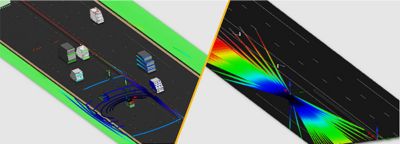-
-
학생용 무료 소프트웨어에 액세스하기
차세대 엔지니어에게 힘을 실어주는 Ansys
학생들은 세계적 수준의 시뮬레이션 소프트웨어를 무료로 이용할 수 있습니다.
-
지금 바로 Ansys에 연결하십시오!
미래를 설계하기
시뮬레이션이 다음 혁신을 어떻게 지원할 수 있는지 알아보려면 Ansys와 연결하십시오.
국가
무료 트라이얼
제품 및 서비스
학습하기
회사 정보
Back
제품 및 서비스
ANSYS BLOG
February 3, 2021
Get Optical Simulation Results up to 60X Faster With Ansys Cloud
You can increase your productivity with new automation capabilities in Ansys Speos and enhance the reliability of advanced driver-assistance systems (ADAS) and autonomous vehicle (AV) simulations with extended sensor simulation features. Speos accelerates innovation with improved workflows, innovative features and new capabilities.
Improve Your Lidar Sensors’ Detection Capabilities
Lidar technology has an important impact on the perception capabilities of today’s cars and trucks, and on the autonomous vehicles of the future. Lidar design and testing are of utmost importance to ensure the reliability of the perception and the safety of the global ADAS/AD systems. But this comes at a cost: It is estimated that testing alone makes up about 40% of lidar research and development costs.
Speos scanning lidar simulation example
To further enable transportation companies to reduce lidar design cost and time via simulation, we have extended lidar capabilities in Ansys Speos 2021 R1 to include scanning and rotating lidar models in addition to the static ones that were already available. Scan and rotation patterns enable you to precisely define the fire sequence of the lidar sensor, adapting it to any situation.
Additionally, you can now analyze the signal received by the lidar sensor and develop more robust detection algorithms thanks to the Raw Time of Flight (ToF) feature. The data input gathered by the Speos-simulated lidar is transmitted to the Raw ToF interface, post-treated and analyzed to enable thorough detection algorithm tests and optimization. Lidar sensor design is now ultrarealistic, covering any type of lidar sensor, enabling you to tune lidar range, detection probability, testing, package size and integration, and performance in difficult weather conditions.
Speed Optical Simulation With Ansys Cloud
Optical simulation has long been constrained by fixed computing resources available on a desktop or cluster. The new Speos accelerates optical simulation to provide results up to 60X faster via Ansys Cloud. You can access Speos from the Ansys Cloud Desktop and combine your optical simulations with other Ansys solutions, such as Ansys Mechanical, Ansys Fluent and Ansys optiSLang, for streamlined and comprehensive simulation results.
Cloud computing delivers the on-demand, high-performance computing (HPC) capacity that will give you faster, high-fidelity optical results, offering greater performance insight.
Learn more about Ansys Speos in Ansys Cloud during our 30-minute webinar.
Increase Your Productivity Through Automation
Automation scripts are no longer nice to have on the job — they are a business necessity. Automating design and testing steps lifts some repetitive tasks off your to-do list.
You can increase your productivity with the new automation capabilities in Ansys Speos which provide complete access to all Speos parameters. Additionally, you can benefit from recording functions and autocompletion capabilities, making scripting easy even for non-experts. It has never been so simple to create a Speos script.
Make Informed Design Decisions With Enhanced Result Visualization
Accurate and reliable result visualization is critical to evaluate optical optimization. Engineering teams can easily make decisions around realistic light visualizations. To achieve this, a GPU acceleration for Speos Live Preview now enables you to display the spectral intensity of light sources in real time to review, for instance, the color bleeding effect of headlamps. It also now computes illuminance sensors, enabling you to quickly review sunburn effects. You can also preview foggy conditions thanks to the ability to display any diffuse material.
In Speos 2021 R1, you can also review human vision results on cutting-edge displays. The latest version is now compatible with HDR10 displays. You can review your Speos Simulation result in HDR to perform virtual mockup reviews at 1:1 luminance, up to 1500 cd/m². This upscales the contrast capability of Ansys Speos, enabling you to see more details in dark and bright tones. These renderings accurately depict how the final system will look in real life, allowing you to evaluate the performance and aesthetics of interior or exterior lighting design.
The same results shown on an HDR screen(left) and normal screen (right)
Ready to go with Speos? Start your Free Trial.

